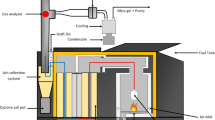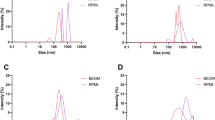Abstract
Many studies showed that there are associations between particulate matter (PM) emissions and negative health effects. Sources for particulate matter PM emissions are, in addition to industry and traffic, residential wood combustion. Such PM emissions consist typically of non-combustible impurities contained naturally within the wood fuels (e.g., ash). Additionally, heavy metals from the wood fuel and/or polycyclic aromatic hydrocarbons (PAHs) formed during incomplete combustions may condense on the surface of these particulate matter and may increase the toxicity of these particles. To reduce negative health effects, wood combustion appliances are forced to emit less PM emissions. This may lead to an increased use of electrostatic precipitators to meet the valid threshold values. Against this background, the overall goal of this paper is it to compare biological effects of PM emissions released under full- and partial-load conditions of a wood pellet boiler with and without a flue gas treatment with an electrostatic precipitator in bacterial assays. The results show that PM emissions emitted under full-load conditions show a lower cytotoxic potential than those collected under partial load. No difference for the genotoxicity between full-load and partial-load conditions could be identified. However, significantly lower genotoxicity during full-load operation and precipitation but higher genotoxicity during partial load and precipitation have been found. Conclusively, the results indicate that the PM emissions emitted under full-load conditions show overall less cytotoxicity and genotoxicity than the emissions from partial-load operation. The PAH concentration doubles between full load and partial load with separator and quadruples between full load and partial load without precipitator.




Similar content being viewed by others
Notes
The excess air ratio λ describes the ratio between the measured amount of combustion air and the theoretically required amount of combustion air. A simplified calculation using the oxygen content of the flue gas measured in vol.-% can be done using the following equation: λ = 21/(21 − O2).
Wasserbeschaffenheit - Bestimmung des erbgutverändernden Potentials in Wasser und Abwasser mittels Umu-Test
Abbreviations
- BCT:
-
Bacterial contact assay
- FAU:
-
Formazine attenuation units (standardized unit for turbidity)
- NOEC:
-
No observed effect level
- SMPS:
-
Scanning mobility particle sizer
- STP:
-
Standard temperature and pressure
- d.b.:
-
Dry basis
- n.d.:
-
Not detectable
- ESP:
-
Electrostatic precipitator
- LOEC:
-
Lowest observed effect concentration
- DL:
-
Dilution level
- ONPG:
-
O-nitrophenyl-β-d-galactopyranoside
- w.b.:
-
Wet basis
References
Kasurinen S, Jalava PI, Tapanainen M, Uski O, Happo MS, Mäki-Paakkanen J, Lamberg H, Koponen H, Nuutinen I, Kortelainen M, Jokiniemi J, Hirvonen MR (2015) Toxicological effects of particulate emissions – a comparison of oil and wood fuels in small- and medium-scale heating systems. Atmos Environ 103:321–330
Lamberg H, Nuutinen K, Tissari J, Ruusunen J, Yli-Pirilä P, Sippula O, Tapanainen M, Jalava P, Makkonen U, Teinilä K, Saarnio K, Hillamo R, Hirvonen MR, Jokiniemi J (2011) Physicochemical characterization of fine particles from small-scale wood combustion. Atmos Environ 45(40):7635–7643
Tapanainen M, Jalava PI, Mäki-Paakkanen J, Hakulinen P, Happo MS, Lamberg H, Ruusunen J, Tissari J, Nuutinen K, Yli-Pirilä P, Hillamo R, Salonen RO, Jokiniemi J, Hirvonen MR (2011) In vitro immunotoxic and genotoxic activities of particles emitted from two different small-scale wood combustion appliances. Atmos Environ 45(40):7546–7554
Kappos AD, Bruckmann P, Eikmann T, Englert N, Heinrich U, Höppe P, Koch E, Krause GHM, Kreyling WG, Rauchfuss K, Rombout P, Schulz-Klemp V, Thiel WR, Wichmann HE (2004) Health effects of particles in ambient air. Int J Hyg Environ Health 207(4):399–407
Pope CA III, Burnett RT, Thun MJ, Calle EE, Krewinski D, Ito K et al (2002) Lung cancer, cardiopulmonary mortality, and long-term exposure to fine particulate air pollution. JAMA 287(9):1132–1141
Naeher LP, Brauer M, Lipsett M, Zelikoff JT, Simpson CD, Koenig JQ, Smith KR (2007) Woodsmoke health effects: a review. Inhal Toxicol 19(1):67–106
Karvosenoja N, Tainio M, Kupiainen K, Tuomisto JT, Kukkonen J, Johansson M (2008) Evaluation of the emissions and uncertainties of PM2.5 originated from vehicular traffic and domestic wood combustion in Finland. Boreal Environ Res 13(5):465–474
Favez O, Cachier H, Sciare J, Sarda-Estève R, Martinon L (2009) Evidence for a significant contribution of wood burning aerosols to PM2.5 during the winter season in Paris, France. Atmos Environ 43(22–23):3640–3644
Kocbach Bølling A, Pagels J, Yttri KE, Barregard L, Sallsten G, Schwarze PE, Boman C (2009) Health effects of residential wood smoke particles: the importance of combustion conditions and physicochemical particle properties. Part Fibre Toxicol 6:29
Nussbaumer T. Characterisation of particles from wood combustion with respect to health relevance and electrostatic precipitation. In: 3rd Central European Biomass Conference: 26th to 29th January 2011, Graz, Austria: Proceedings; 2011
Kaltschmitt M, Hartmann H, Hofbauer H (2016) Energie aus Biomasse: Grundlagen, Techniken und Verfahren, 3rd edn. Springer Vieweg, Berlin, Heidelberg
Nussbaumer T, Lauber A (2010) Verhalten von Staub und Teer in Elektroabscheidern. Holz-Zentralblatt:1126–1128
Nussbaumer T (2003) Combustion and co-combustion of biomass: fundamentals, technologies, and primary measures for emission reduction. Energy Fuel 17(6):1510–1521
Nussbaumer T, Lauber A (2010) Formation mechanisms and physical properties of particles from wood combustion for design and operation of electrostatic precipitators. In: ETA-Florence Renewable Energies, editor. Proceedings of the 18th European Biomass Conference and Exhibition, 3–7 May 2010
Löndahl J, Pagels J, Boman C, Swietlicki E, Massling A, Rissler J, Blomberg A, Bohgard M, Sandström T (2008) Deposition of biomass combustion aerosol particles in the human respiratory tract. Inhal Toxicol 20(10):923–933
Nussbaumer T, Hasler P (1999) Bildung und Eigenschaften von Aerosolen aus Holzfeuerungen. Holz Roh Werkst 57(1):13–22
Ghafghazi S, Sowlati T, Sokhansanj S, Bi X, Melin S (2011) Particulate matter emissions from combustion of wood in district heating applications. Renew Sust Energ Rev 15(6):3019–3028
Boman C, Nordin A, Boström D, Öhman M (2004) Characterization of inorganic particulate matter from residential combustion of pelletized biomass fuels. Energy Fuel 18(2):338–348
Pöschl U (2005) Atmospheric aerosols: composition, transformation, climate and health effects. Angew Chem Int Ed 44(46):7520–7540
Uski O, Jalava PI, Happo MS, Leskinen J, Sippula O, Tissari J, Mäki-Paakkanen J, Jokiniemi J, Hirvonen MR (2014) Different toxic mechanisms are activated by emission PM depending on combustion efficiency. Atmos Environ 89:623–632
Forbes EGA, Easson DL, Lyons GA, McRoberts WC (2014) Physico-chemical characteristics of eight different biomass fuels and comparison of combustion and emission results in a small scale multi-fuel boiler. Energy Convers Manag 87:1162–1169
Kaivosoja T, Jalava PI, Lamberg H, Virén A, Tapanainen M, Torvela T, Tapper U, Sippula O, Tissari J, Hillamo R, Hirvonen MR, Jokiniemi J (2013) Comparison of emissions and toxicological properties of fine particles from wood and oil boilers in small (20–25 kW) and medium (5–10 MW) scale. Atmos Environ 77:193–201
Sippula O, Hokkinen J, Puustinen H, Yli-Pirilä P, Jokiniemi J (2009) Particle emissions from small wood-fired district heating units. Energy Fuel 23(6):2974–2982
Oekotube » Schräder Abgastechnologie; Available from: https://www.schraeder.com/oekotube
Dekati® FPS | DEKATI; Available from: https://www.dekati.com/products/Aerosol%20Sample%20Conditioning/Dekati%C2%AE%20FPS
Condensation Particle Counter 3772 | TSI; Available from: http://tsi.com/condensation-particle-counter-3772/
DeCarlo PF, Slowik JG, Worsnop DR, Davidovits P, Jimenez JL (2004) Particle morphology and density characterization by combined mobility and aerodynamic diameter measurements. Part 1: theory. Aerosol Sci Technol 38(12):1185–1205
Good J, Nussbaumer T (1993) Wirkungsgradbestimmung bei Holzfeuerungen. In: Zürich
Leskinen J, Tissari J, Uski O, Virén A, Torvela T, Kaivosoja T et al (2014) Fine particle emissions in three different combustion conditions of a wood chip-fired appliance – particulate physico-chemical properties and induced cell death. Atmos Environ 86:129–139
Happo MS, Uski O, Jalava PI, Kelz J, Brunner T, Hakulinen P, Mäki-Paakkanen J, Kosma VM, Jokiniemi J, Obernberger I, Hirvonen MR (2013) Pulmonary inflammation and tissue damage in the mouse lung after exposure to PM samples from biomass heating appliances of old and modern technologies. Sci Total Environ 443:256–266
Rönnpagel K, Liss W, Ahlf W (1995) Microbial bioassays to assess the toxicity of solid-associated contaminants. Ecotoxicol Environ Saf 31(2):99–103
DIN 38412–48: 2002–09. German standard methods for the examination of water, waste water and sludge - Bio-assays (group L) - Part 48: Toxicity test with Arthrobacter globiformis for contaminated solids (L 48)
Heise S, Ahlf WA (2005) New microbial contact assay for marine sediments. J Soils Sediments 5(1):9–15
Toolaram AP, Gutiérrez IR, Ahlf W (2012) Modification of the umu-assay (ISO 13829) accounting for cytotoxicity in genotoxicity assessment: a preliminary study. Mutat Res-Gen Tox En 747(2):190–196
Oda Y, Nakamura S-i, Oki I, Kato T, Shinagawa H (1985) Evaluation of the new system (umu-test) for the detection of environmental mutagens and carcinogens. Mutat Res-Envir Muta 147(5):219–229
Nakamura S-i, Oda Y, Shimada T, Oki I, Sugimoto K (1987) SOS-inducing activity of chemical carcinogens and mutagens in Salmonella typhimurium TA1535/pSK1002: examination with 151 chemicals. Mutat Res Lett 192(4):239–246
Acknowledgments
Parts of this study have been performed in the framework of the ToxOAb project.
Funding
The research leading to these results has received funding from the Federal Ministry of Education and Research under funding reference number 03KB090A.
Author information
Authors and Affiliations
Corresponding author
Additional information
Publisher’s note
Springer Nature remains neutral with regard to jurisdictional claims in published maps and institutional affiliations.
Highlights
- The cytotoxic potential of particulate matter (PM) emissions of an investigated pellet boiler seems to be higher if samples were taken downstream an electrostatic precipitator under full-load conditions.
- The genotoxicity of the particulate matter emission within the flue gas was significantly reduced by the precipitator during full-load operation but increased during partial load.
Rights and permissions
About this article
Cite this article
Schulze, AL., Büchner, D., Klix, V. et al. Biological effects of particulate matter emissions from residential pellet boilers in bacterial assays: influence of an electrostatic precipitation. Biomass Conv. Bioref. 9, 227–239 (2019). https://doi.org/10.1007/s13399-018-0358-y
Received:
Revised:
Accepted:
Published:
Issue Date:
DOI: https://doi.org/10.1007/s13399-018-0358-y




